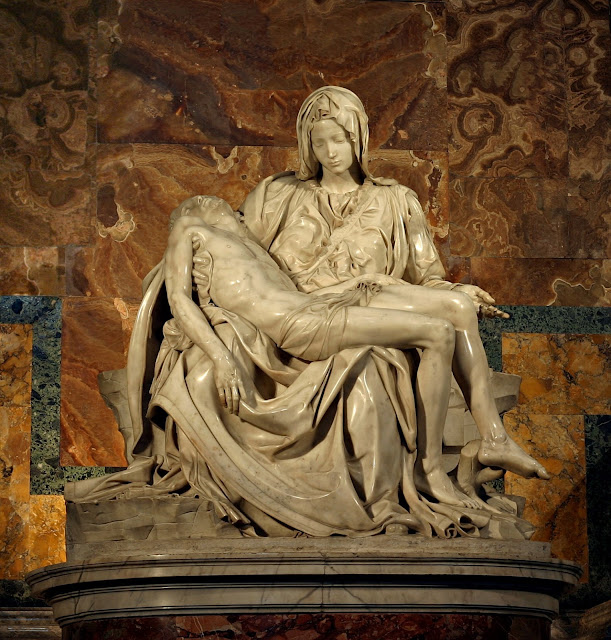Pieta

The Pietà (1498–1499) is a work of Renaissance sculpture by Michelangelo Buonarroti, housed in St. Peter's Basilica, Vatican City. It is the first of a number of works of the same theme by the artist. The statue was commissioned for the French Cardinal Jean de Bilhères, who was a representative in Rome. The sculpture, in Carrara marble, was made for the cardinal's funeral monument, but was moved to its current location, the first chapel on the north side of the entrance of the basilica, in the 18th century. It is the only piece Michelangelo ever signed.
This famous work of art depicts the body of Jesus on the lap of his mother Mary after the Crucifixion. The theme is of Northern origin. Michelangelo's interpretation of the Pietà is unprecedented in Italian sculpture. It is an important work as it balances the Renaissance ideals of classical beauty with naturalism.
In 2019, a small terracotta figure identified as a model for the final sculpture was displayed in Paris.
The structure is pyramidal, and the vertex coincides with Mary's head. The statue widens progressively down the drapery of Mary's dress, to the base, the rock of Golgotha. The figures are quite out of proportion, owing to the difficulty of depicting a fully-grown man cradled full-length in a woman's lap. Much of Mary's body is concealed by her monumental drapery, and the relationship of the figures appears quite natural. Michelangelo's interpretation of the Pietà was far different from those previously created by other artists, as he sculpted a young and beautiful Mary rather than an older woman around 50 years of age.
The marks of the Crucifixion are limited to very small nail marks and an indication of the wound in Jesus' side.
Christ's face does not reveal signs of the Passion. Michelangelo did not want his version of the Pietà to represent death, but rather to show the "religious vision of abandonment and a serene face of the Son," thus the representation of the communion between man and God by the sanctification through Christ.
When Michelangelo set out to create his Pietà, he wanted to create a work he described as "the heart's image".
Following completion, the Pietà's first home was the Chapel of Santa Petronilla, a Roman mausoleum near the south transept of St. Peter's, which the Cardinal chose as his funerary chapel. The chapel was later demolished by Bramante during his rebuilding of the basilica. According to Giorgio Vasari, shortly after the installation of his Pietà, Michelangelo overheard someone remark (or asked visitors about the sculptor) that it was the work of another sculptor, Cristoforo Solari, whereupon Michelangelo signed the sculpture.
Michelangelo carved MICHAELA[N]GELUS BONAROTUS FLORENTIN[US] FACIEBA[T] (Michelangelo Buonarroti, Florentine, was making this) on the sash running across Mary's chest. The signature echoes one used by the ancient Greek artists, Apelles and Polykleitos. It was the only work he ever signed. Vasari also reports the anecdote that Michelangelo later regretted his outburst of pride and swore never to sign another work of his hands.
In 1964, the Pietà was lent by the Vatican to the 1964–65 New York World's Fair to be installed in the Vatican pavilion. Francis Cardinal Spellman, who had requested the statue from Pope John XXIII, appointed Edward M. Kinney, Director of Purchasing and Shipping of Catholic Relief Services - USCC, to head up the Vatican Transport Teams. The statue was shipped in a wooden crate 2.5 inches (6.4 cm) thick with an 8-inch (20 cm) base, secured to the deck of the liner Cristoforo Colombo; in case of accident, the crate contained cushioning so thick that it would float in water, and had an emergency locator beacon as well as a marker buoy attached. At the fair, people stood in line for hours to catch a glimpse from a conveyor belt moving past the sculpture. It was returned to the Vatican afterwards

Comments
Post a Comment